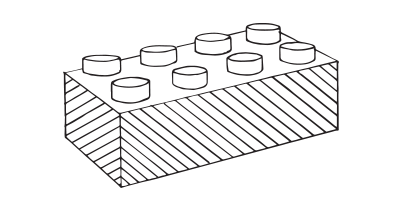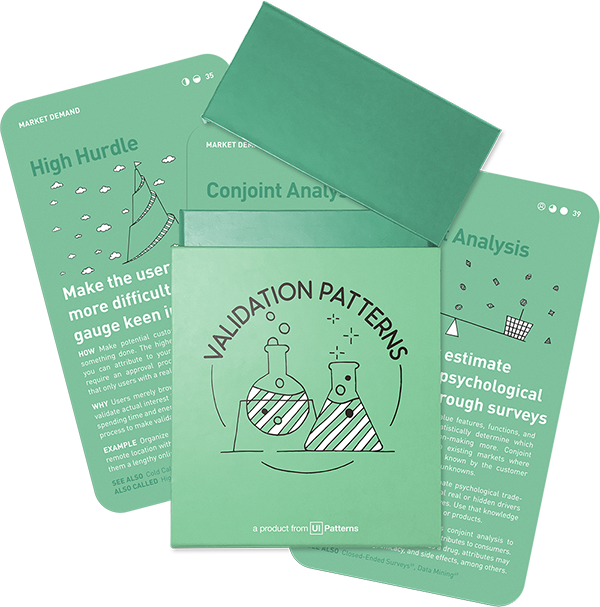Idea Validation: Product
LEGO prototype
Quickly assemble and tweak a rough model of a physical product

How: Take advantage of Lego bricks' ubiquity and versatility to create quick and simple prototypes of your physical product that are easy to dismantle and tweak.
Why: Lego bricks can help you to quickly assemble a physical prototype that can give users an impression of form and function. Furthermore, Lego bricks allow for quick alterations making them an obvious prototyping tool for co-creation.
Lego prototyping is a low-fidelity, physical prototyping technique that brings playful exploration into the heart of product discovery and design. It allows individuals and teams to quickly visualize and test ideas using Lego bricks instead of more conventional sketching or digital wireframes. More than just building blocks, Lego pieces become a tangible language for experimentation, communication, and shared understanding.
Used most effectively in early discovery, this method helps cross-functional teams ideate, align, and engage in co-creative problem solving. From modeling workflows to imagining service experiences or even simulating software systems, Lego prototypes reveal insights not just through their physical form but also through the conversations and metaphors they spark.
Why use LEGOs for prototyping?
Lego prototyping shines when you’re exploring ambiguous ideas, working across disciplines, or trying to uncover hidden assumptions. The act of building invites everyone—regardless of skill level or job title—to participate in shaping an idea. It replaces the pressure of drawing or coding with a universally accessible toolset that’s inherently flexible, visual, and tactile.
Lego bricks encourage iteration. It’s easy to swap parts, add components, or restructure entire systems on the fly. This adaptability supports divergent thinking and helps groups compare alternatives without investing in higher-fidelity prototypes too early. Unlike wireframes or diagrams, Lego models are open to interpretation, which encourages storytelling and deeper exploration of meaning.
Lego Serious Play, a structured facilitation approach developed by the Lego Group, expands on these principles by prompting participants to build models in response to abstract or strategic questions. This method is particularly powerful for workshops aiming to surface values, share perspectives, or align around purpose.
Lego also supports systems thinking. Because teams are working with physical components, they naturally start to simulate interconnections, dependencies, and flows. This is particularly helpful when modeling service environments or complex processes where cause and effect may not be immediately obvious.
When and how to use LEGO prototyping
Lego prototyping is most useful in the early and exploratory phases of product development. It can be used to:
- Explore how a service might work in physical or spatial terms
- Prototype an interface metaphor or multi-step workflow
- Visualize how users might move through an environment or interact with various components
- Facilitate stakeholder alignment by translating abstract concepts into visible systems
- Stimulate systems-level thinking about organizational challenges or product ecosystems
To begin, define the objective of your session. Are you exploring a problem, illustrating a system, or imagining a solution? Next, prepare a diverse set of Lego bricks—ideally with enough variety to model different scales, functions, or ideas. Invite a cross-functional group of participants and offer prompts or challenges that frame the building activity.
Encourage individual or group builds, followed by presentations and discussions. Participants explain their models using metaphor, which often reveals deeper thinking or tensions between perspectives. Emotions often emerge naturally as part of these narratives, offering insight into stakeholder perspectives that might otherwise remain implicit.
If using the Lego Serious Play method, follow its four structured steps: pose a question, build a model, share its meaning, and reflect collectively. This structured engagement encourages equal participation and makes space for meaning-making.
Capture photos and key observations during the session, and synthesize recurring themes or insights. You might translate Lego models into journey maps, service blueprints, or digital wireframes later in the process.
LEGO prototyping compared to other fidelity prototyping
In terms of fidelity, Lego prototyping is among the lowest. It prioritizes ideas and interaction over polish or precision. Compared to paper prototyping, Lego offers a more spatial and tangible form of expression. Paper sketches are often used to represent screen layouts, while Lego models can simulate systems, roles, physical flows, and relationships.
Clickable prototypes move the fidelity forward, providing a way to test user interaction with interfaces. However, they typically assume a settled direction for the solution. Lego, by contrast, supports earlier-stage exploration where the concept itself is still forming. Working prototypes, which include functionality, are best suited for validating refined solutions. Lego sits at the opposite end of the spectrum—ideal for when you don’t yet know what to build, but need to explore possibilities.
Lego can serve as a conceptual bridge. A Lego model might lead to a paper sketch, which then becomes a digital wireframe or interactive mockup. Used this way, Lego helps teams align early before investing in more resource-heavy artifacts.
Experiment pairing: what comes before and after
Lego prototyping is rarely a standalone activity. It often benefits from being preceded by generative research—such as customer interviews, ethnographic studies, or discovery surveys—that help surface needs and context. These insights can shape the prompts and focus of your Lego session.
After a Lego session, follow-up experiments can include:
- Paper prototypes to sketch UI implications of the concepts explored
- Storyboarding to narrate user journeys derived from the models
- Concept testing to validate metaphors or systemic ideas with real users
- Clickable prototypes to bring abstract Lego ideas into interactive form
- Service blueprinting to map touchpoints and backend systems suggested by the Lego model
By pairing Lego prototyping with other research and testing methods, teams maintain a thread of discovery that moves ideas from abstract to tangible—from early exploration to grounded validation.
Not just play: what makes it valuable
The value of Lego prototyping doesn’t lie in aesthetic polish—it lies in the process. By externalizing thoughts and seeing others do the same, teams develop shared understanding faster. Building physical representations also helps surface blind spots: what’s missing, what’s overcomplicated, what assumptions are going unspoken.
Using Lego also disarms hierarchy. Engineers, designers, executives, and users can all contribute equally. The bricks become a neutral language that invites play and reduces defensiveness. For this reason, Lego prototyping is often used in co-creation sessions with users, aligning not just the design team, but the people it serves.
It also brings an emotional and narrative dimension into design work. When participants build models that represent experiences, values, or challenges, they often embed feelings, metaphors, and stories into the design. These stories offer a richer understanding of user perspectives and deepen empathy.
Getting it right
Use time-boxed building rounds to maintain focus and encourage flow. Avoid over-instructing—it’s okay if people build abstractly. Provide context, but leave room for interpretation. If using Lego Serious Play techniques, work with a trained facilitator and include reflective prompts and storytelling as part of the flow.
Lego sessions can also be documented effectively. Photos, sticky notes, or voice recordings of model explanations can all be used to analyze and synthesize insights. You might translate Lego models into journey maps, service blueprints, or digital wireframes later in the process.
Be mindful of the medium’s limitations. Lego bricks are great for abstract representation and physical spatial modeling, but they don’t lend themselves to detail-rich visual design or precise interaction modeling. The goal isn’t to produce realistic UI mockups or clickable prototypes—it’s to explore concepts, systems, and meaning.
When not to use LEGO prototyping
Lego prototyping is not ideal for detailed usability testing or visual design decisions. It won’t tell you how users click through a screen or which UI layout is most intuitive. And while it can be used for exploratory conversations, it’s less helpful when the team already has high alignment or when a problem space is tightly constrained.
It also requires some facilitation skill. Without structure or framing, Lego sessions can become unfocused or superficial. The method works best when paired with a clear question, a collaborative spirit, and a follow-up plan to turn findings into next steps.
Real life LEGO prototype examples
3D printing combined with Legos
Waiting 5 hours for a 3D printer to be done can sometimes be too long. This is why prototype professionals are beginning to swap the parts of your 3D print that you don’t need printed, with blocks of LEGO to make rapid prototyping even faster by minimizing the components that needs to come from a 3D printer.
Source: Replacing Parts of 3D-Printed Models With Lego Speeds Up Prototyping
IDEO insulin injection
IDEO used Lego bricks to create multiple prototypes for complex insulin injection devices before even starting to think about real production.
A collection of 60 product experiments that will validate your idea in a matter of days, not months. They are regularly used by product builders at companies like Google, Facebook, Dropbox, and Amazon.
Get your deck!Related plays
- Lego Prototypes by Interaction Design Foundation at Interaction Design Foundation
- Lego Prototyping — Boosting Creativity by Alexandra McCall at Medium
- Co-discover UX using the LEGO Serious Play® method by Annie Wang at UX Collective
- Using LEGO Serious Play as a Design Thinking Tool by Rafiq Elmansy at Designorate
- Lego, Engineering & Low Fidelity Prototyping by Accu Team at Accu Components
